HIV-associated central nervous system diseases in the recent combination antiretroviral therapy era
Some of the data contained in this manuscript were presented at the 12th European AIDS Conference (EACS), Cologne, Germany, 11–14 November 2009 (oral PS6/5).
Abstract
Background and purpose: Data describing the incidence and survival of HIV-related central nervous system diseases (CNS-D) in recent years are sparse.
Methods: Between 1996 and 2007, adult subjects without previous CNS-D within a large UK cohort were included (n = 30 954). CNS-D were HIV encephalopathy (HIVe), progressive multifocal leucoencephalopathy (PML), cerebral toxoplasmosis (TOXO) and cryptococcal meningitis (CRYP). Associations between demographic, clinical and laboratory parameters with incidence and survival of CNS-D were evaluated using Poisson regression analysis and Kaplan–Meier techniques.
Results: Six hundred and thirteen new CNS-D occurred in 574 subjects (HIVe:187, PML:113, TOXO:184, CRYP:129). Incidence of all CNS-D declined from 13.1 per 1000 PY in 1996/1997 to 1.0 per 1000 PY in 2006/2007 (P = 0.0001). Current CD4+ cell count below 200 cells/ul and plasma HIV RNA above 100 000 copies/ml were independently associated with the development of CNS-D. Calendar year 1996/1997, older age, prior AIDS diagnosis and PML diagnosis were significantly associated with shorter survival.
Conclusions: An ongoing decline in the incidence of CNS-D has been observed in very recent years. Mortality following such a diagnosis remains high.




